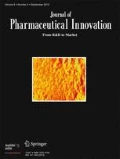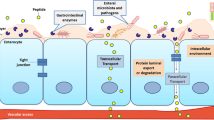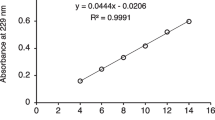Abstract
Purpose
The aim of the study was to improve bioavailability of paliperidone, a class II drug, via cocrystallization with a peep to the effect of HPMC as a precipitation inhibitor (PPI). An attempt was made to prepare paliperidone cocrystals with benzamide, boric acid, nicotinamide, and PHBA as coformers after the prediction of cocrystal formation using Hansen solubility parameter (HSP) as a prediction tool.
Method
The cocrystals were prepared, with a 1:1 M ratio of drug and coformer, by the solvent evaporation method. The prepared cocrystals were characterized by melting point, saturation solubility and in vitro drug release along with instrumental analytical techniques such as FTIR, DSC, PXRD, and SEM.
Results
The formation of paliperidone cocrystals using benzamide, nicotinamide, and PHBA was confirmed, as predicted by HSP, by collective assessment of the results. On the other hand, the formation of paliperidone cocrystals by boric acid could not be proved. These findings revealed the suitability of HSP as a cocrystal formation prediction tool. In spite of this, the successfully prepared paliperidone-PHBA (PAL-PHBA) cocrystals had shown a tremendous increase in their solubility (0.115 mg/ml to 16.29 mg/ml, 141.6 fold) and dissolution (49% in 60 min to100 % release in 30 min) when compared to the pure drug. Therefore, these cocrystals further studied for paliperidone bioavailability in albino rabbits, in the presence and absence of HPMC as a PPI. The results showed an improvement in the bioavailability of paliperidone in the presence of precipitation inhibitor.
Conclusion
Thus cocrystallization and precipitation inhibition technique increases the bioavailability of the drug.







Similar content being viewed by others
References
Sinha AS, Maguire AR, Lawrence SE. Cocrystallization of nutraceuticals. Cryst Growth Des. 2015;15(2):984–1009.
Zhao L, Hanrahan MP, Chakravarty P, DiPasquale AG, Sirois LE, Nagapudi K, et al. Characterization of pharmaceutical cocrystals and salts by dynamic nuclear polarization-enhanced solid-state NMR spectroscopy. Cryst Growth Des. 2018;18(4):2588–601.
Stoler E, Warner JC. Non-covalent derivatives: Cocrystals and eutectics. Molecules. 2015;20(8):14833–48.
Elbagerma MA, Edwards HGM, Munshi T, Scowen IJ. Identification of a new cocrystal of citric acid and paracetamol of pharmaceutical relevance. CrystEngComm. 2011;13(6):1877–84.
Blagden N, de Matas M, Gavan PT, York P. Crystal engineering of active pharmaceutical ingredients to improve solubility and dissolution rates. Adv Drug Deliv Rev. 2007;59(7):617–30.
Yadav AV, Shete AS, Dabke AP, Kulkarni PV, Sakhare SS. Co-crystals: a novel approach to modify physicochemical properties of active pharmaceutical ingredients. Indian J Pharm Sci. 2009;71(4):359–70.
Malamatari M, Ross SA, Douroumis D, Velaga SP. Experimental cocrystal screening and solution based scale-up cocrystallization methods. Adv Drug Deliv Rev. 2017;117:162–77.
Izutsu KI, Koide T, Takata N, Ikeda Y, Ono M, Inoue M, et al. Characterization and quality control of pharmaceutical cocrystals. Chem Pharm Bull (Tokyo). 2016;64(10):1421–30.
Korotkova EI, Kratochvíl B. Pharmaceutical cocrystals. Procedia Chemistry. 2014;10:473–6.
Gadade DD, Pekamwar SS. Pharmaceutical cocrystals: regulatory and strategic aspects, design and development. Adv Pharm Bull. 2016;6(4):479–94.
Saganowska P, Wesolowski M. DSC as a screening tool for rapid co-crystal detection in binary mixtures of benzodiazepines with co-formers. J Therm Anal Calorim. 2018;133(1):785–95.
Schultheiss N, Newman A. Pharmaceutical cocrystals and their physicochemical properties. Cryst Growth Des. 2009;9(6):2950–67.
Rekdal M, Pai A, Choudhari R, Sathyanarayana MB. Applications of co-crystals in pharmaceutical drugs. Systematic Reviews in Pharmacy. 2018;9(1):55–7.
Sudalai Kumar S, Ranjit T, Ashwini N. Pharmaceutical cocrystals and a nitrate salt of voriconazole. Cryst Eng Comm. 2014;16:4722–31.
Thipparaboina R, Kumar D, Chavan RB, Shastri NR. Multidrug co-crystals: towards the development of effective therapeutic hybrids. Drug Discov Today. 2016;21(3):481–90.
Panzade P, Shendarkar G, Shaikh S, BalmukundRathi P. Pharmaceutical cocrystal of piroxicam: design, formulation and evaluation. Adv Pharm Bull. 2017;7(3):399–408.
Stahly GP. Diversity in single- and multiple-component crystals. The search for and prevalence of polymorphs and cocrystals. Cryst Growth Des. 2007;7(6):1007–26.
Bevill MJ, Vlahova PI, Smit JP. Polymorphic cocrystals of nutraceutical compound p-coumaric acid with nicotinamide: characterization, relative solid-state stability, and conversion to alternate stoichiometries. Cryst Growth Des. 2014;14(3):1438–48.
Thakuria R, Sarma B. Drug-drug and drug-nutraceutical cocrystal/salt as alternative medicine for combination therapy: a crystal engineering approach. Crystals. 2018;8(2):101.
Salem A, Nagy S, Pal S, Szechenyi A. Reliability of the Hansen solubility parameters as co-crystal formation prediction tool. Int J Pharm. 2019;558:319–27.
Kitak T, Dumičić A, Planinšek O, Šibanc R, Srčič S. Determination of solubility parameters of ibuprofen and ibuprofen lysinate. Molecules. 2015:20(12).
Xu S, Dai W-G. Drug precipitation inhibitors in supersaturable formulations. Int J Pharm. 2013;453(1):36–43.
Chavan RB, Thipparaboina R, Kumar D, Shastri NR. Evaluation of the inhibitory potential of HPMC, PVP and HPC polymers on nucleation and crystal growth. RSC Adv. 2016;6(81):77569–76.
Xiao L, Yi T. Mechanisms of hydroxypropyl methylcellulose for the precipitation inhibitor of supersaturatable self-emulsifying drug delivery systems. Yao XueXueBao. 2013;48(5):767–72.
Zhang L, Li J, Zhao Y, Su YA, Si T. Critical evaluation of paliperidone in the treatment of schizophrenia in Chinese patients: a systematic literature review. Neuropsychiatr Dis Treat. 2016;12:113–31.
Pandey A, Rath B, Dwivedi AK. Dissolution rate enhancement of bcs class ii drug, paliperidone by spray drying. Res J Pharm, Biol Chem Sci. 2013;4:145–55.
Janicak PG, Winans EA. Paliperidone ER: a review of the clinical trial data. NeuropsychiatrDis Treat. 2007;3(6):869–97.
Pandey A, Rath B, Dwivedi AK. Dissolution rate and bioavailability enhancement of co-ground mixtures of paliperidone, with different hydrophilic carriers. Int Curr Pharm J. 2013;2(3):70–7.
Shete A, Murthy S, Thorat B, Yadav A, Sajane S, Sakhare S, et al. Studies on effect of hydrophilic polymers on physicochemical properties of itraconazole cocrystals. Future Journal of Pharmaceutical Sciences. 2017;3(2):95–102.
Mohammad MA, Alhalaweh A, Velaga SP. Hansen solubility parameter as a tool to predict cocrystal formation. Int J Pharm. 2011;407(1–2):63–71.
Funding
We appreciate the financial support from Rajiv Gandhi University of Health Sciences, Bangalore, India for carrying out the research work.
Author information
Authors and Affiliations
Corresponding author
Additional information
Publisher’s Note
Springer Nature remains neutral with regard to jurisdictional claims in published maps and institutional affiliations.
Rights and permissions
About this article
Cite this article
Thimmasetty, J., Ghosh, T., Nayak, N.S. et al. Oral Bioavailability Enhancement of Paliperidone by the use of Cocrystalization and Precipitation Inhibition. J Pharm Innov 16, 160–169 (2021). https://doi.org/10.1007/s12247-020-09428-2
Published:
Issue Date:
DOI: https://doi.org/10.1007/s12247-020-09428-2




